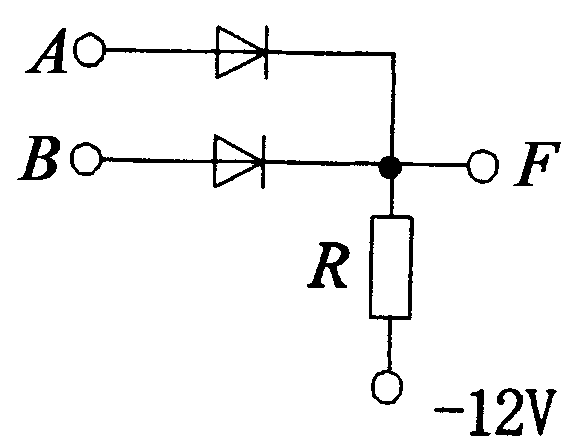1.磁电式传感器属于模拟量传感器,利用磁路欧姆定律。( )
A:对
B:错
答案:对
2.磁路欧姆定律不能直接用于计算,只能用于定性分析。( )
A:对
B:错
答案:对
3.RLC串联电路的有功功率等于电阻 上的有功功率。( )
A:正确
B:错误
答案:正确
4.通常规定,自由电子运动的方向为电流的方向。 ( )
A:对
B:错
答案:错
5.根据楞次定律,当原磁通减小时,感应电动势的磁通与原磁通方向相同。( )
A:错
B:对
答案:对
6.蓄电池在电路中必定是电源,总是把化学能转换为电能。( )
A:对
B:错
答案:错
7.所有流入节点的电流之和等于所有流出节点的电流之和。( )
A:对
B:错
答案:对
8.电路中有3点A、B、C,已知电压UAB=8V,UBC=-7V,则电压UAC=15V。( )
A:错
B:对
答案:错
9.已知 ,则 是不可能的。( )
A:错误
B:正确
答案:错误
10.三相异步电动机,定子的作用是产生旋转的磁场。( )
A:对
B:错
答案:对
11.交流电的频率越大,感抗越大。( )
A:错
B:对
A:错 B:对 13.比较器属于集成运算放大器的非线性应用。( )
A:对 B:错 14.稳压管是PN结工作在反偏状态下的二极管。( )
A:对 B:错 15.列节点电流方程时,电流的方向是实际电流方向。( )
A:对 B:错 16.汽车发电机整流器采用三相桥式整流电路将交流电转换为直流电。( )
A:对 B:错 17.分析理想集成运放的两个重要依据分别是“虚短”和“虚断”,其中“虚断”是指u+≈u-。( )
A:对 B:错 18.对称三相星形接法电路,线电压与相电压相等。( )
A:错 B:对 19.正弦交流电路的视在功率等于有功功率和无功功率之和。( )
A:正确 B:错误 20.一节点连有3条支路,其电流分别为I1、I2、I3,参考方向均离开节点,如果I1、I2均为正值,则I3一定为负值。( )
A:对 B:错 21.霍尔式传感器属于数字量传感器。 ( )
A:对 B:错 22.光电式传感器属于数字量传感器。( )
A:对 B:错 23.在纯电感交流电路中,在相位上电压超前电流90o。( )
A:正确 B:错误 24.永磁式刮水电动机是通过改变磁极磁通来实现变速的。( )
A:错 B:对 25.将二进制数110111,转换为十六进制数是( )。
A:37 B:47 C:67 D:57 26.将二进制数110111,转换为八进制数是( )。
A:37 B:47 C:67 D:57 27.五色环电阻的第四环代表的是( )。
A:倍乘数 B:允许误差 C:十位有效数字 D:个位有效数字 28.1+1=1是( )。
A:八进制相加 B:逻辑加 C:二进制相加 D:十进制数相加 29.将二进制数1111111转换为二进制数是( )。
A:7F B:3F C:FF D:EF 30.RLC串联电路中,如果阻抗角
 ,则电路呈( )。
,则电路呈( )。A:电感性 B:电容性 C:电阻性 D:不确定 31.在如图所示电路中,F与A、B的逻辑关系是( )。

A:F= B: C:F=A+B D:F=A·B 32.三相异步交流电动机定子的作用是( )。
A:产生三相交流电 B:产生旋转的磁场 C:变交流为直流 D:调节电压 33.车间动力线路的电压是( )V。
A:380 B:110 C:220 D:36 34.将十进制数26转换为二进制数,即(26)10=( )2。
A:11011 B:11010 C:10110 D:10011 35.电路中有三点A,B,C,已知电压UAB=5V,UBC=-3V,则电压UAC为( )。
A:2V B:-2V C:8V D:-8V 36.三极管各极电流之间的关系是( )。
A:IE=IB-IC B:IC=IE+IB C:IB=IE+IC D:IE=IB+IC 37.RC串联电路的阻抗模(|Z|)等于( )。
A: .w65141243736s .brush0 { fill: rgb(255,255,255); } .w65141243736s .pen0 { stroke: rgb(0,0,0); stroke-width: 1; stroke-linejoin: round; } .w65141243736s .font0 { font-style: italic; font-size: 406px; font-family: "Times New Roman", serif; } .w65141243736s .font1 { font-style: italic; font-size: 373px; font-family: Symbol, serif; } .w65141243736s .font2 { font-size: 373px; font-family: Symbol, serif; } .w65141243736s .font3 { font-weight: bold; font-size: 76px; font-family: System, sans-serif; } C j R w - B: .w65141243747s .brush0 { fill: rgb(255,255,255); } .w65141243747s .pen0 { stroke: rgb(0,0,0); stroke-width: 1; stroke-linejoin: round; } .w65141243747s .pen1 { stroke: rgb(0,0,0); stroke-width: 16; stroke-linejoin: round; } .w65141243747s .pen2 { stroke: rgb(0,0,0); stroke-width: 32; stroke-linejoin: round; } .w65141243747s .font0 { font-size: 262px; font-family: "Times New Roman", serif; } .w65141243747s .font1 { font-size: 406px; font-family: "Times New Roman", serif; } .w65141243747s .font2 { font-size: 373px; font-family: Symbol, serif; } .w65141243747s .font3 { font-style: italic; font-size: 406px; font-family: "Times New Roman", serif; } .w65141243747s .font4 { font-style: italic; font-size: 373px; font-family: Symbol, serif; } .w65141243747s .font5 { font-weight: bold; font-size: 76px; font-family: System, sans-serif; } 2 2 1 ÷ ø ö ç è æ + C R w C: .w65141243742s .brush0 { fill: rgb(255,255,255); } .w65141243742s .pen0 { stroke: rgb(0,0,0); stroke-width: 1; stroke-linejoin: round; } .w65141243742s .pen1 { stroke: rgb(0,0,0); stroke-width: 16; stroke-linejoin: round; } .w65141243742s .font0 { font-style: italic; font-size: 406px; font-family: "Times New Roman", serif; } .w65141243742s .font1 { font-style: italic; font-size: 373px; font-family: Symbol, serif; } .w65141243742s .font2 { font-size: 406px; font-family: "Times New Roman", serif; } .w65141243742s .font3 { font-size: 373px; font-family: Symbol, serif; } .w65141243742s .font4 { font-weight: bold; font-size: 76px; font-family: System, sans-serif; } C j R w 1 + D: .w65141243741s .brush0 { fill: rgb(255,255,255); } .w65141243741s .pen0 { stroke: rgb(0,0,0); stroke-width: 1; stroke-linejoin: round; } .w65141243741s .font0 { font-size: 473px; font-family: Symbol, serif; } .w65141243741s .pen1 { stroke: rgb(0,0,0); stroke-width: 16; stroke-linejoin: round; } .w65141243741s .pen2 { stroke: rgb(0,0,0); stroke-width: 32; stroke-linejoin: round; } .w65141243741s .font1 { font-size: 262px; font-family: "Times New Roman", serif; } .w65141243741s .font2 { font-style: italic; font-size: 406px; font-family: "Times New Roman", serif; } .w65141243741s .font3 { font-style: italic; font-size: 373px; font-family: Symbol, serif; } .w65141243741s .font4 { font-size: 373px; font-family: Symbol, serif; } .w65141243741s .font5 { font-weight: bold; font-size: 76px; font-family: System, sans-serif; } ( ) 2 2 C R w + 38.一只三极管的β=50,当IB=10μA时,发射极电流为( )mA。
A:0.5mA B:0.2mA C:0.51mA D:1mA 39.一只NPN型三极管,基极电位Vb=4.7V, 发射极电位Ve=4V ,集电极电位Vc=4.2V,则该三极管的工作状态为( )。
A:放大 B:截止 C:不确定 D:饱和 40.晶体三极管工作于放大状态时,( )
A:发射结反偏,集电结正偏 B:发射结正偏,集电结反偏 C:发射结正偏,集电结正偏 D:发射结反偏,集电结反偏 41.若输入变量A、B全为1时,输出F=0,则其输入与输出的关系是( )。
A:与非 B:与 C:异或 D:或非 42.测量放大电路中三极管的管压降Uce近似等于电源电压,则该管处于( )状态。
A:不能确定 B:放大 C:截止 D:饱和 43.用集成运算放大器构成功能电路,要实现Au=-50的目的,应选用( )电路。
A:同相比例运算放大电路 B:反相比例运算放大电路 C:差分运算放大电路 D:D.比较器电路 44.组合逻辑电路在电路结构上只包含( )。
A:开关电路 B:反馈电路 C:各种门电路 D:各种触发器 45.当电源电压的有效值和电源频率不变时,变压器负载运行和空载运行时的主磁通( )。
A:完全相同 B:基本不变 C:负载运行比空载时大 D:空载运行时比负载时大
温馨提示支付 ¥3.00 元后可查看付费内容,请先翻页预览!


